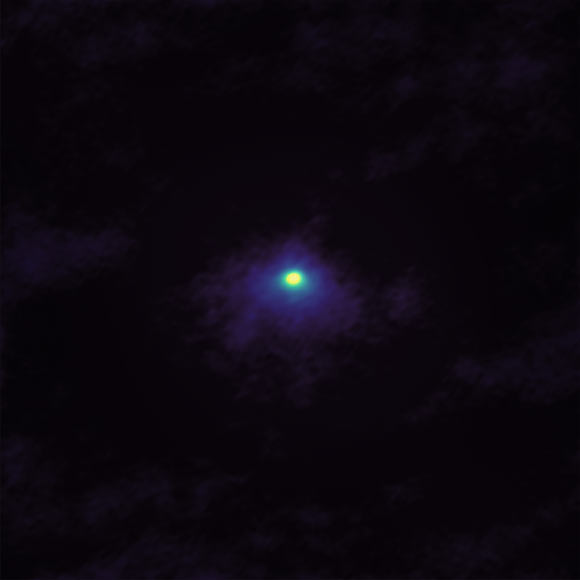Astronomers using the Atacama Large Millimeter/submillimeter Array (ALMA) captured the radio image of 46P/Wirtanen on December 2, 2018, when the comet was about 10.3 million miles (16.5 million km) from Earth.

ALMA image of 46P/Wirtanen taken on December 2, 2018, as the comet approached Earth. The image shows the concentration and distribution of HCN molecules near the center of the comet’s coma. Image credit: ALMA / ESO / NAOJ / NRAO / M. Cordiner / NASA / CUA.
Comet 46P/Wirtanen was discovered on January 17, 1948, by the American astronomer Carl Wirtanen.
With a width of 0.7 miles (1.1 km), the comet is a member of the Jupiter family of comets — their farthest point from the Sun being near the orbit of Jupiter.
It orbits the Sun once every 5.4 years, which is remarkably brisk compared to its more famous cousin comet Halley, which has an orbital period of about 75 years.
“Comet 46P/Wirtanen is causing a stir in the professional and amateur astronomy communities due to its combined brightness and proximity, which allows us to study it in unprecedented detail,” said team leader Dr. Martin Cordiner, a research associate at the Department of Physics, Catholic University of America and an astrochemist and astrobiologist at NASA’s Goddard Space Flight Center.
“As the comet drew nearer to the Sun, its icy body heated up, releasing water vapor and various other particles stored inside, forming the characteristic puffed-up coma and elongated tail.”
The ALMA image of 46P/Wirtanen zooms-in to very near its nucleus — the solid ‘dirty snowball’ of the comet itself — to image the natural millimeter-wavelength ‘glow’ emitted by molecules of hydrogen cyanide (HCN), a simple organic molecule that forms an ethereal atmosphere around the comet.
ALMA was able to detect and image the fine-scale distribution of HCN molecules.
The image shows a compact region of gas and an extended, diffuse, and somewhat asymmetrical, pattern in the inner portion of the coma.
Due to the extreme proximity of this comet, most of the extended coma is resolved out, so these observations are only sensitive to the innermost regions, in the immediate vicinity of the nucleus.
The astronomers also performed observations of more complex molecules on December 9, 2018, when the comet was 8.5 million miles (13.6 million km) from Earth.
“This and previous observations of comets with ALMA confirm that they are rich in organic molecules, and may therefore have seeded the early Earth with the chemical building blocks of life,” they said.







